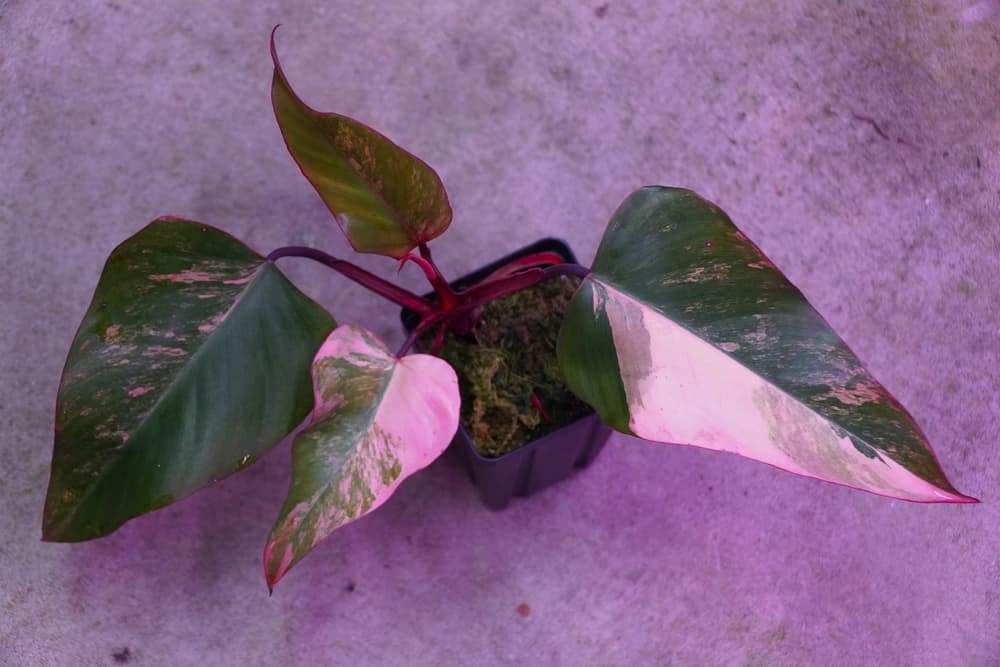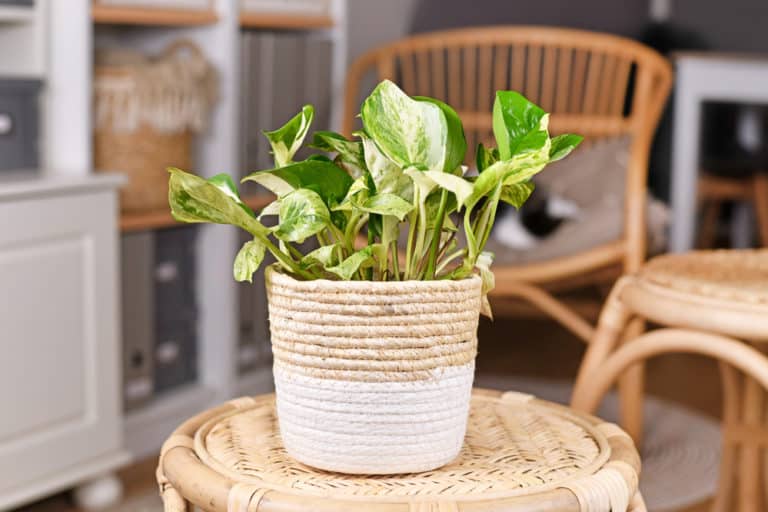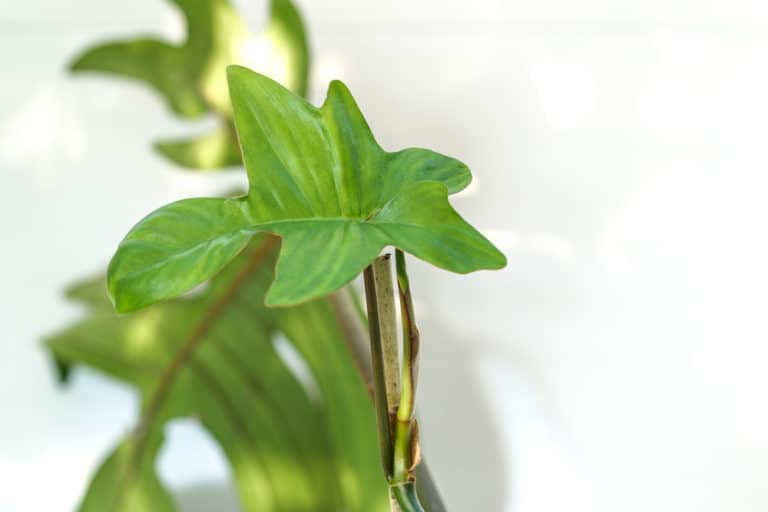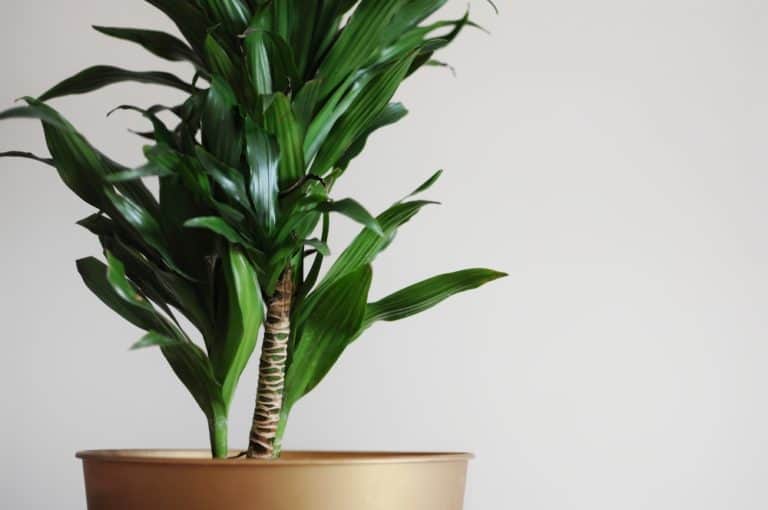Philodendron Erubescens ‘Strawberry Shake’ Care Guide (2024)

If you want a Philodendron strawberry shake, be prepared to pay big bucks for this tropical beauty with variegated leaves in shades of yellow, orange, and red.
Even a rooted cutting can cost more than $400.
However, despite that steep price it’s very much in demand and as a result the supply of this philodendron cultivar is limited.
| Scientific Name | Philodendron erubescens ‘Strawberry Shake’ |
| Common Name | Strawberry Shake Philodendron |
| Light | Bright indirect sunlight |
| Watering | Water if the top 2 inches of soil are dry |
| Temperature | 55 to 80ºF (12 to 27ºC) |
| Hardiness Zone | 9b to 11 |
| Humidity | 60 to 70% |
| Soil Type | Rich, quick-draining, loamy |
| Soil pH | 5 to 7 (acidic to neutral) |
| Fertilizing | A balanced feed once a month in spring and summer |
| Repotting | Every 2 to 3 years |
| Pruning | As needed to remove dead leaves |
| Propagation | Root in water or soil |
| Toxicity | Toxic to humans and pets |
| Mature Size | 36 inches as a houseplant |
| Bloom Time | Rarely flowers indoors |
What’s Unique About Strawberry Shake Philodendron?
The strawberry shake Philodendron plant was first discovered in the wild in Ecuador in the 1990s.
It’s a naturally-occurring hybrid of Philodendron erubescens, which is native to the tropical rainforests of equatorial South America.
Strawberry shake Philodendron plants have large leaves randomly patterned in shades of red, pink, orange, yellow, and cream.
Growing strawberry shake Philodendron is not difficult, but because of its high price tag you will not want to make any mistakes when taking care of this tropical plant.
Not only will strawberry shake Philodendron provide you with a visual feast, but it will also improve your air quality as it filters out harmful chemicals.
Strawberry Shake Philodendron Care
In the equatorial rainforests where strawberry shake Philodendron originates, it grows in a hot and humid environment in the dappled shade of the tree canopy.
Your strawberry shake Philodendron plant care should provide similar conditions.
Good strawberry shake plant care is about warm temperatures, high humidity, and a spot with plenty of bright but indirect light.
Light
In the tropical rainforests of South America, the strawberry shake Philodendron is protected from the direct rays of the sun by the tree canopy.
In your home, strawberry shake Philodendron light requirements are for bright, indirect light, or between 10,000 to 20,000 lux.
While bright light will result in the best color variegation, full sun will burn the delicate leaves.
You can best meet your strawberry shake plant light needs in a south-facing room, but you need to find a spot where the direct rays of the sun won’t touch it.
That way, it will get lots of bright, ambient light without being exposed to the harmful rays.
If you do not have bright enough natural light you can use a plant light.
Watering
In the rainforests, strawberry shake Philodendron evolved to expect rain every other day or so in spring, summer, and fall, while the winter months are drier.
Your strawberry shake Philodendron watering should follow a similar pattern, but don’t water strawberry shake plant on a strict schedule.
Instead, water only when the top 2 inches of the soil have dried out. Check the soil moisture every few days to ascertain its watering needs.
Pour tepid water slowly over the soil surface to let it absorb rather than running right through.
Never let the water that drains through sit in the pot’s saucer, as the roots will not tolerate wet soil.
Temperature
It’s hot in the equatorial rainforests. Average highs are around 82ºF (28ºC), and nighttime lows don’t dip below 68ºF (20ºC).
You don’t have to sweat to make your tropical plant happy, though; the acceptable strawberry shake Philodendron temperature range is 60 to 80ºF (15 to 27ºC).
Obviously, if you can provide a higher temperature for strawberry shake plant, it will love the extra heat, but indoors in winter, if you’re comfortable, it will be too.
You can move it outdoors in summer for additional heat, but it has little temperature tolerance below 55ºF (12ºC), so be sure to move it in when temperatures drop.
It has no frost hardiness at all, and freezing temperatures will kill it.
Humidity
The humidity in strawberry shake Philodendron’s native rainforests is always between 70 and 80%.
Strawberry shake Philodendron humidity requirements can be a little challenging in a modern home, but you should strive to give it as high a humidity level as possible.
The ideal humidity for strawberry shake plant is 60 to 70%.
While it may be okay at 40%, a lower humidity level can result in leaves that are curled or have brown edges.
You can try misting the leaves every day or setting the pot on a pebble tray filled with water.
However, the best way to ensure that your strawberry shake Philodendron is getting all the humidity it needs is by using a small humidifier.
Soil
Strawberry shake Philodendron soil has to both retain moisture but also drain away excess, as this plant will not tolerate sitting in sopping wet soil.
The acceptable pH level for strawberry shake plant is in a wide range from 5 to 7, or acidic to neutral.
The best commercial soil for strawberry shake plant is an aroid mix, which is formulated to exactly meet its needs.
You can also make your own soil mix with 40% orchid bark, 30% potting soil, 20%peat moss, and 10% perlite.
The easiest thing to do is just use 100% peat moss as your potting soil.
Fertilizer
You do not want to use too much strawberry shake Philodendron fertilizer, as a build-up of chemical salts in the soil can cause serious damage.
The best fertilizer for strawberry shake plant is slow-release granules with a fertilizer ratio of 15-5-10.
Apply it to the soil at the beginning of spring, summer, and fall. Do not spread the granules evenly over the soil surface, but rather closer to the outside edge of the pot.
If you do use a liquid fertilizer, dilute it to half the recommended strength and apply once a month in spring and summer right after you’ve watered.
Potting & Repotting
Strawberry shake Philodendron repotting should be done every 2 to 3 years, or whenever you see that the plant is becoming rootbound.
You’ll know that’s happening when you see roots growing out of the drainage holes, or taking up most of the space in the pot.
For repotting strawberry shake plant, move it up one pot size, as too great a volume of soil will tend to stay too wet.
You can use a glazed or unglazed clay pot, or a plastic one. Just make sure that it has good drainage holes.
Always use fresh potting soil when you repot your strawberry shake Philodendron.
Pruning
There’s hardly any strawberry shake Philodendron pruning to do, as this is a plant that grows at a moderate pace and naturally forms an attractive shape.
However, you can cut it if it’s getting too big for your tastes.
You also should trim off any dead or damaged leaves whenever they occur. They not only look terrible, but they also can attract disease or insects.
The one other reason for cutting strawberry shake plant is if new growth has reverted back to solid green. To restore the variegation, cut back the stem to below where the non-variegation begins.
When cutting, use sharp, sterilized scissors.
Propagation
For such a rare plant, strawberry shake Philodendron propagation is really quite easy.
The easiest way to propagate strawberry shake plant is to cut a length of stem with aerial roots. Lay it down lengthwise on a moist growing medium with the roots in contact with the soil.
Keep it warm and moist and out of the sun, and within a month you should have several rooted plants to cut apart and plant out separately.
You can also take stem cuttings with at least one node and one leaf. Put them in a jar or in moist soil, and within 1 or 2 months they will form roots.
Also, make sure to check out our in-depth white princess Philodendron plant care guide.
Common Problems of Strawberry Shake Philodendron
You might expect a rare and expensive plant like the strawberry shake Philodendron to have lots of potential problems, but it really doesn’t.
Most strawberry shake Philodendron problems can be prevented by simply following care instructions carefully.
If you do have problems with strawberry shake plant, you will see it first in the leaves, so make regular examination of the foliage part of your routine.
Pests
You can avoid having to deal with strawberry shake Philodendron pests with a simple preventative measure.
You should wipe down the leaves of your strawberry shake plant once a month to keep them clean. If you add neem oil to the solution, you can keep bugs away.
Spider mites can spin webs and leave little yellow spots that will lead to serious damage.
Aphids are little green bugs that suck the sap on the stems and underside of the leaves.
You can clean both of these bugs off by giving the plant a good shower.
Scale insects attach themselves to the stems and leaves, looking like brown bumps. Scrape them off.
Mealybugs make their home under the leaves, forming white fuzzy colonies. Wipe them off with a cotton ball dipped in rubbing alcohol.
Diseases
Most strawberry shake Philodendron diseases are able to take hold because of too much wetness on the leaves and in the soil.
Root rot is the most common disease affecting the strawberry shake plant. When the soil stays wet, a fungal disease causes blackened roots, yellow leaves, and mushy stems.
Cut off all infected portions and replant it in fresh soil.
Leaf spot can be caused by a bacterial or fungal disease. Cut off all affected foliage and improve air circulation around your plant.
Mosaic virus causes leaves to curl and wrinkle and develop a mosaic pattern.
Stem rot leads stems to turn brown and mushy and quickly progresses from soil level to the leaves.
Neither disease can be cured and you should dispose of your plant before they can spread to others.
Growing Problems
If your strawberry shake Philodendron has growing problems, it’s time for you to pay more attention to the conditions your sick plant needs to thrive.
Brown leaf tips can be an indication of low humidity or compacted soil.
Drooping leaves usually mean you’ve been underwatering your strawberry shake Philodendron. Give it a good soaking to perk it back up.
Yellow leaves may be caused by overwatering or really low light conditions.
Green leaves may also indicate that your strawberry shake Philodendron needs more light to develop its distinctive variegation, which is the main attraction of this rare and expensive plant.
Toxicity of Strawberry Shake Philodendron
Like all members of the Araceae family, the strawberry shake plant is toxic to humans and household pets.
While the toxicity of the strawberry shake Philodendron is not enough to trigger a fatal reaction, the calcium oxalate crystals found in parts of the plant can cause pain and gastrointestinal issues.
For Humans
While strawberry shake Philodendron is mildly toxic to humans, exposure will rarely require medical attention.
You should wear gloves when handling the plant, as the sap can cause a painful rash in sensitive individuals. If it gets on your skin, rinse it off.
Children may get into a little more trouble with it, as they are incredibly curious and may try eating a leaf.
They probably won’t take more than one bite, because the calcium oxalate crystals will cause almost immediate pain as they pierce the delicate tissues in the mouth.
Rinse their mouth out and give them a cold treat to help with the pain, but if they are having trouble breathing or have a swollen tongue, take them to the emergency room.
For Pets
Ingestion of strawberry shake Philodendron foliage can be a more serious matter for your pets.
If your cat, dog, or rabbit ingests foliage, and starts wheezing or drooling excessively or has vomiting and diarrhea, you can’t treat it yourself.
Take your pet to the veterinarian as soon as possible, as they can develop organ damage from the calcium oxalate crystals.
The best way to prevent an incident like that is by finding a spot for your strawberry shake Philodendron that pets and toddlers can’t reach.
This may mean placing a young plant on a high ledge, or placing a larger climbing strawberry shake Philodendron behind a trellis or low fence at floor level.
Strawberry Shake Philodendron Appearance
The multicolored foliage creates a unique strawberry shake Philodendron appearance.
While this hybrid cultivar is expensive, some growers take the chance to buy a reverted strawberry shake Philodendron.
These are plants that have lost their variegated appearance and have solid green leaves.
They take it as a challenge to restore the variegation by providing the strawberry shake Philodendron with perfect growing conditions.
Foliage
The foliage of strawberry shake Philodendron is of course why this rare and expensive tropical houseplant is in such high demand.
When a new leaf unfurls, they are a pale salmon orange or pink. As they mature, they develop irregular blotches in shades of red, pink, cream, and green. The stems are deep red.
The long, oval or triangular leaves grow to 8 to 12 inches long and 5 to 7 inches wide.
They have a thick, leathery texture with a smooth surface.
To keep these long-lasting leaves looking their best, wipe them down monthly to avoid an accumulation of dust, as well as deterring insects.
Flowering
The strawberry shake plant flower is rarely if ever seen on plants grown in pots indoors.
Indoor vines simply don’t mature to a point where they can support strawberry shake Philodendron flowering.
However, if you are able to grow a strawberry shake Philodendron outdoors year-round in a tropical climate similar to its native habitat, you may see it blooming.
Flowers are white, with a spathe wrapped around a spadix. They have no scent.
It’s really not worth the effort to try to get your potted strawberry shake Philodendron to bloom.
The wonderfully variegated leaves are the only reason for buying and growing this expensive tropical plant.
Size and Growth
It is possible for the size of strawberry shake Philodendron to reach 4 to 6 feet.
However, that is more typical for a plant grown outdoors in a tropical zone, where it can be planted in the ground.
Most strawberry shake Philodendrons grown indoors as potted plants top out at about 3 feet, with a spread of 1 foot.
Strawberry shake Philodendron has a moderate to fast growth rate, but will grow faster when it is staked with a sphagnum moss pole.
The aerial roots grab onto the organic matter and get moisture and nutrients from it, as they would from a tree trunk in the wild.
Strawberry Shake Philodendron Fragrance
There is no strawberry shake Philodendron fragrance. Even the rare flowers have no scent.
However, strawberry shake Philodendron has some really positive benefits for the quality of your home’s air.
Not only do all philodendrons produce a lot of oxygen to replenish your air supply, but they also filter large amounts of formaldehyde.
That’s a toxic chemical used in many manufactured goods in your home, such as pressed wood products and fabrics.
As well, plants with no scent are better for people with sensitivities or allergies to strong fragrances. That’s why they are preferred for public places such as stores and office buildings.
Suggested Uses for Strawberry Shake Philodendron
A strawberry shake Philodendron plant should be given pride of place, whether you use it indoors or outside. It’s a rare plant you will want to show off to anyone who visits your home.
Since it is naturally a climbing plant, giving it a sphagnum moss pole to climb in a bright corner of a living room will let it flaunt its gorgeous leaves.
It’s also a good plant for a brightly-lit bathroom, where it will love the extra humidity.
You can also move it outdoors to a balcony or patio in summer so it can get an extra dose of heat and humidity. Just make sure you find a spot where it gets some protection from the sun.
FAQ
What is strawberry shake Philodendron?
The strawberry shake Philodendron is a naturally-occurring hybrid of Philodendron erubescens, first discovered in Ecuador in the 1990s. It is a rare and expensive potted plant.
How to identify strawberry shake Philodendron?
The strawberry shake Philodendron has large, oval to triangular leaves splashed with shades of red, orange, pink, cream, and green. It grows as a climbing vine.
How to care for strawberry shake Philodendron?
The strawberry shake Philodendron should be grown in a bright spot out of the direct sun, in a warm and humid setting with regular watering.
How to grow strawberry shake Philodendron indoors?
The strawberry shake Philodendron can be grown as a potted houseplant in a humid environment with normal household temperatures, in a location with lots of bright but indirect light.
How to grow strawberry shake Philodendron outdoors?
The strawberry shake Philodendron can be grown outdoors year-round in zones 9b to 11, or taken out to a balcony or patio in summer in temperate regions.
How fast does strawberry shake Philodendron grow?
The strawberry shake Philodendron has a moderate to fast growth rate, adding about a foot a year in its growing season. It takes 3 years to reach its full size.
How tall does strawberry shake Philodendron grow?
The strawberry shake Philodendron will typically reach a height of 3 feet when grown indoors as a potted plant, but outdoors in a tropical climate it can grow to 6 feet tall.
How to make strawberry shake Philodendron grow faster?
The strawberry shake Philodendron will grow its fastest when it is staked with a sphagnum moss pole and grown in high temperatures and humidity in a bright setting.
How to stake strawberry shake Philodendron?
The strawberry shake Philodendron can be staked with a sphagnum moss pole. The aerial roots will grab onto the moss and draw nutrients from it.
How to pot strawberry shake Philodendron?
The strawberry shake Philodendron should be potted in loose, rich soil with plenty of organic matter, in a glazed or unglazed pot with good drainage holes.
How to revive strawberry shake Philodendron?
The strawberry shake Philodendron may revert to plain green leaves. Cut the growth back to before the variegation stops, and move the pot to a brighter location.
Why is my strawberry shake Philodendron dying?
Your strawberry shake Philodendron may have a bacterial or fungal disease that you can cure by cutting out all infected parts. However, if it has Mosaic virus, you cannot save it.
Why is my strawberry shake Philodendron drooping?
Your strawberry shake Philodendron may be too dry or too wet. Check the soil moisture levels, and either give it a good soaking or replant it in well-draining soil.
How cold can strawberry shake Philodendron tolerate?
The strawberry shake Philodendron grows well between 60 to 80ºF (15 to 27ºC), will sustain damage below 55ºF (12ºC), and will be killed by frost.
How to get rid of pests on strawberry shake Philodendron?
Strawberry shake Philodendron pests can be deterred by wiping down both sides of the leaves at least once a month with a neem oil solution.
Is strawberry shake Philodendron toxic to cats?
Yes, the strawberry shake Philodendron is toxic to cats. If your cat has vomiting or diarrhea, take it to the veterinarian as soon as possible.
Is strawberry shake Philodendron toxic to dogs?
Yes, the strawberry shake Philodendron is toxic to dogs. If your dog is wheezing, drooling excessively, or vomiting, you should take it to the veterinarian at once.
Is strawberry shake Philodendron toxic to children?
Yes, the strawberry shake Philodendron is toxic to children. If your child eats some foliage and has a swollen tongue or difficulty breathing, take them to the emergency room.
Is strawberry shake Philodendron toxic to humans?
Yes, the strawberry shake Philodendron is toxic to humans. The sap can cause a painful rash, so wear gloves and rinse off any sap that gets on your skin.
Does strawberry shake Philodendron have a scent?
The strawberry shake Philodendron foliage has no scent, and neither do the rare flowers. It is a good plant to use around people with fragrance sensitivities.





